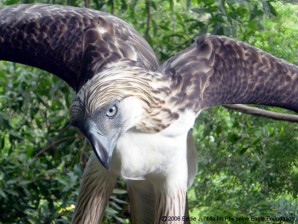First Philippine eagle bred in captivity turns 20

Pag-asa will turn 20 on Sunday. Still at the prime of its life, the first Philippine Eagle bred and hatched in captivity has yet to produce an offspring. Photos courtesy of Philippine Eagle Foundation
DAVAO CITY, Philippines—Pag-asa, the first Philippine Eagle bred and hatched in captivity, turns 20 on Sunday, but with neither a mate nor an offspring.
Pag-asa’s successful hatching in 1992 was considered a breakthrough, giving conservationists hope of beefing up the dwindling eagle population and leading to other successful hatching efforts in that year and the next.
At 20, Pag-asa is at the prime of his life, according to biologist Anna Mae Sumaya, the curator of the Philippine Eagle Foundation (PEF) breeding program in Malagos here. (The oldest eagle at the eagle farm is 43 years old.)
Eagles are supposed to reach sexual maturity at five years of age. But Pag-asa’s semen production has been sporadic, preventing successful artificial insemination despite the best efforts of PEF conservationists.
“People keep asking about Pag-asa’s offspring. They think he already has one,” Sumaya said.
Suspecting that the eagle might be stressed by his proximity to humans, conservationists have isolated him from visitors since 2005.
“He does not like the company of people except for his surrogate parent/mate,” Sumaya said, referring to eagle caretaker Eddie Juntilla.
Pagasa has been “imprinted” with humans, Sumaya said. She said that since the eagle was hatched, he has identified closely with Juntilla as his parent and, during the mating season, as his mate.
Imprinting is defined as a rapid learning process that takes place early in the life of an animal and establishes a behavior pattern involving recognition of and attraction to identifiable attributes of its own kind or a substitute.
“Pag-asa depends for most of his needs, including food, on humans. It’s possible that he has also identified himself with humans,” Sumaya said.
During the breeding months from July to February, Juntilla brings Pag-asa sprigs from hardwood trees, playing the part of the female eagle during courtship.
But unlike other eagles in the wild, Pag-asa has never performed an aerial display, such as a dive chase during courtship or a paired soaring flight during the mating season.
“If you see him spreading his wings from end to end and wagging his tail, then be prepared. It’s the eagle’s attack position,” Sumaya said, chuckling.
It being the mating season, people visiting Pag-asa on his birthday will be only allowed to stand 15-20 meters from where he perches.
But they will also be treated to some games aimed at heightening awareness of the Philippine Eagle and its importance.
Conservation efforts are “a tool” to restore the eagle population, according to PEF executive director Dennis Salvador.
“But we are unable to cope with the threats that eagles encounter in the wild,” Salvador said. “Many of them still get shot at, and at the rate this is going on, we are in grave danger of losing the Philippine Eagle.”
Sumaya agreed, saying that the country was losing more eagles faster than the PEF could breed them at the eagle farm. She said that eagles with gunshot wounds kept turning up at the PEF Center, and that often the injuries were too grave for the birds to survive.
Philippine eagles hatch an egg only once every two years, explained Jayson Ibañez, PEF director for research.
“What makes the conservation task more daunting is the fact that by biological design, the bird is a slow breeder—one egg in every two years. But the high mortality rate makes it very difficult to replace one eagle killed in the wild,” Ibañez said.
But the more serious threats are logging and mining activities, which continue to put pressure on the country’s remaining forests, Salvador said.
He said the call for conservation was even more urgent now, with the country beginning to feel the effects of climate change and global warming.
“Twenty years ago, we were already saying that we have to invest in saving the eagle, saving the forest, because that’s the only way we can save ourselves. If we had only invested in the past, then we won’t have as grave a problem as we have now,” he said.















